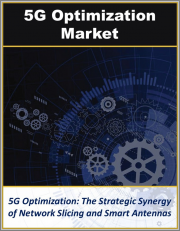
|
시장보고서
상품코드
1511368
세계의 네트워크 슬라이싱 시장 : 컴포넌트별, 용도별, 최종 사용자별, 지역별 분석 및 예측(-2030년)Network Slicing Market Forecasts to 2030 - Global Analysis By Component (Standard, Step and Other Types), Application (Telecom operators, Network Function Virtualization and Other Applications), End User and By Geography |
||||||
Stratistics MRC에 따르면 세계 네트워크 슬라이싱 시장은 2024년에 11억 2,000만 달러를 차지하고, 예측 기간 동안 복합 연간 성장률(CAGR)은 48.0%로 성장할 전망이며, 2030년에는 118억 달러에 이를 것으로 예측됩니다.
네트워크 슬라이싱은 통신의 개념으로, 단일 물리적 네트워크를 슬라이스라고 하는 여러 가상 네트워크로 분할할 수 있습니다. 각 슬라이스는 대역폭, 지연, 보안, 신뢰성 등 특정 요구 사항을 충족하도록 사용자 지정되며 다양한 애플리케이션 및 서비스에 맞게 조정됩니다. 이 기술을 통해 네트워크 리소스를 효율적으로 공유할 수 있는 동시에 독립적으로 작동하는 분리된 전용 가상 네트워크를 제공할 수 있습니다. 네트워크 슬라이싱은 자율 주행 차량에서 스마트 시티에 이르기까지 다양한 이용 사례가 존재하는 5G와 같은 신기술에 매우 중요하며 최적으로 기능하기 위해서는 별도의 네트워크 특성이 필요합니다.
GSMA에 따르면 네트워크 슬라이싱은 다른 인에이블러 및 기능과 결합하여 2025년까지 3,000억 달러에 해당하는 수익 기회를 처리하는 데 도움이 됩니다. ETNO(유럽의 통신 네트워크 사업자 협회)의 조사에 따르면 IoT 헬스케어의 활성 연결 수는 해마다 증가할 것으로 예상됩니다. 2016년에는 87만 접속이었지만 2025년에는 1,034만 접속에 이를 것으로 예상되고 있습니다.
IoT와 M2M 통신
네트워크 슬라이싱 시장에서 사물인터넷과 기계간 통신은 수요와 혁신을 촉진하는 요인으로 중요한 역할을 합니다. 센서에서 스마트 가전에 이르는 광범위한 IoT 디바이스는 낮은 지연, 높은 신뢰성, 확장 가능한 연결성과 같은 특정 네트워크 특성을 필요로 하지만, 네트워크 슬라이싱은 이러한 요구에 맞는 가상 네트워크를 구축함으로써 효율적입니다. 에 제공할 수 있습니다. 사람을 통하지 않고 디바이스 간의 데이터 교환을 자동화하는 M2M 통신은 산업 자동화 및 스마트 시티 등 다양한 용도에 전용 리소스와 최적화된 성능을 확보함으로써 네트워크 슬라이싱의 이점을 누릴 수 있습니다.
리소스 관리
이 영역의 주요 제약은 대역폭, 컴퓨팅 전력, 네트워크 용량 등의 자원 할당을 여러 슬라이스간에 동시에 효과적으로 관리하고 균형을 맞추는 문제입니다. 서비스 품질(QoS) 요구 사항이 다른 다양한 슬라이스가 동일한 물리적 네트워크 인프라에 공존하면 점점 더 복잡해집니다. 공정한 할당 확보, 리소스 경쟁 방지, 실시간 수요에 따른 리소스 할당 동적 조정 등의 문제는 네트워크 슬라이스의 성능과 신뢰성을 유지하는 데 매우 중요합니다.
가상화 및 클라우드 서비스
가상화와 클라우드 서비스는 네트워크 리소스의 효율적이고 유연한 배포를 가능하게 함으로써 네트워크 슬라이싱 시장에 큰 기회를 제공합니다. 가상화를 통해 네트워크는 물리적 인프라에서 추상화되어 단일 물리적 네트워크에 여러 가상 네트워크(슬라이스)를 쉽게 만들 수 있습니다. 클라우드 서비스는 확장 가능한 컴퓨팅 및 스토리지 리소스를 주문형으로 제공함으로써 가상화를 보완하고 동적 네트워크 슬라이싱 요구 사항을 지원하는 데 필수적입니다. 가상화와 클라우드 서비스를 결합하여 통신 제공업체는 IoT 용도의 저지연 및 비디오 스트리밍의 고대역폭을 포함하여 특정 사용자 요구에 맞게 맞춤화되고 최적화된 네트워크 슬라이스를 제공할 수 있습니다.
비용 및 ROI 불확실성
네트워크 슬라이싱 시장에서는 여러 요인들로부터 비용과 ROI 불확실성이 큰 위협이 되고 있습니다. 네트워크 슬라이싱 인프라를 도입하는 데 필요한 선행 투자는 엄청날 수 있으며, 비용은 배포의 복잡성과 규모에 따라 달라집니다. 불확실성은 이러한 초기 비용을 정확하게 예측하고 예상 리턴과의 무결성을 보장하는 어려움으로 인해 발생합니다. 네트워크 슬라이싱의 투자 수익률(ROI)은 시장 수요, 기술 진보, 규제 변경 등의 요인에 영향을 받으며, 모두 시간이 지남에 따라 변동될 수 있습니다. 이 변동성으로 인해 이해관계자가 예상 수익성을 예측하고 예상 기한 내에 달성하기가 어렵습니다.
COVID - 19의 영향 :
COVID - 19의 유행은 여러면에서 네트워크 슬라이싱 시장에 큰 영향을 미쳤습니다. 원격 근무, e - 러닝 및 원격 의료 요구 증가에 대응하기 위해 견고하고 유연한 네트워크 인프라에 대한 수요가 가속화되고 슬라이싱 기술에 대한 투자가 촉진되었습니다. 또한 다양한 수요에 따라 자원을 동적으로 할당할 수 있는 탄력적인 네트워크의 중요성이 강조되어 핵심 기술로서의 네트워크 슬라이싱의 채용이 촉진되었습니다. 마지막으로, 온라인 활동이 급증하면서 원활한 연결성을 보장하기 위해서는 신뢰성이 높고 지연이 적은 네트워크가 필요하다는 것이 강조되어 네트워크 슬라이싱 시장의 세계 성장을 더욱 촉진하고 있습니다.
예측 기간 동안 통신 사업자 부문이 최대가 될 전망입니다.
통신 사업자는 여러 요인에 의해 네트워크 슬라이싱 시장에서 큰 성장을 이루고 있습니다. 네트워크 슬라이싱을 통해 통신 사업자는 특정 고객 요구에 맞게 공통 물리적 인프라에 여러 가상 네트워크를 구축할 수 있습니다. 이러한 유연성을 통해 운영자는 확장 모바일 광대역, 초고신뢰 저지연 통신(URLLC), 대규모 머신 통신(mMTC)과 같은 차별화된 서비스를 제공할 수 있습니다. 네트워크 슬라이싱을 활용함으로써 사업자는 자원을 효율적으로 할당하고, 서비스 품질을 향상시키고, 제조, 헬스케어, 스마트 시티 등의 분야에서 다양한 고객 수요에 대응할 수 있습니다.
예측 기간 동안 복합 연간 성장률(CAGR)이 가장 높을 것으로 예상되는 자동차 분야
자동차 분야에서는 첨단 커넥티비티와 자율주행 기술이 자동차에 통합되어 네트워크 슬라이싱 시장이 크게 성장하고 있습니다. 네트워크 슬라이싱을 통해 자동차 제조업체와 서비스 제공업체는 자율 주행, V2X(Vehicle - to - Everything) 통신, 자동차 엔터테인먼트 시스템 등 특정 자동차 용도에 맞는 전용 가상 네트워크를 구축할 수 있습니다. 자동차 네트워크가 복잡해지고 광대역 및 저지연 서비스에 대한 수요가 증가함에 따라 네트워크 슬라이싱은 네트워크 리소스를 효율적으로 관리하고 최적화하는 확장 가능한 솔루션을 제공하여 자동차 분야의 혁신과 보급을 촉진합니다.
최대 점유율을 차지하는 지역
북미는 몇 가지 중요한 요소로 네트워크 슬라이싱 시장에서 큰 성장을 이루고 있습니다. 이 지역의 고도의 통신 인프라와 5G 기술의 보급은 사업자가 다양한 용도에 맞게 네트워크 리소스를 커스터마이징 및 최적화할 수 있는 네트워크 슬라이싱의 도입에 적합한 토양을 만들어 내고 있습니다. 또한 향상된 모바일 광대역 서비스, IoT 연결, 자율주행 차량 및 산업 자동화와 같은 저지연 용도에 대한 강한 수요가 있으며, 이들 모두 네트워크 슬라이싱 기능을 통해 큰 혜택을 누리고 있습니다.
복합 연간 성장률(CAGR)이 가장 높은 지역 :
아시아태평양은 여러 요인으로 인해 네트워크 슬라이싱 시장이 크게 성장하고 있습니다. 통신 인프라가 중국, 인도, 일본, 한국 등의 국가에서 급속히 확대되고 있기 때문에 효율적인 네트워크 관리와 커스터마이징에 대한 수요가 높아지고 있습니다. 네트워크 슬라이싱은 특정 용도 요구사항에 따라 네트워크 자원을 동적으로 할당하는 능력을 통신 사업자에게 제공하여 네트워크 전체의 효율성과 사용자 경험을 향상시킵니다. IoT, 자율주행차, 강화된 모바일 광대역 등 다양한 서비스를 지원하기 위해 네트워크 슬라이싱에 크게 의존하는 5G 기술의 출현으로 이 지역에서는 이 기술에 대한 투자와 배포가 증가하고 있습니다.
무료 사용자 정의 서비스 :
이 보고서를 구독하는 고객은 다음 무료 맞춤설정 옵션 중 하나를 사용할 수 있습니다.
- 기업 프로파일
- 추가 시장 기업의 종합적 프로파일링(3개사까지)
- 주요 기업의 SWOT 분석(3개사까지)
- 지역 세분화
- 고객의 관심에 응한 주요국 시장 추계,예측,복합 연간 성장률(CAGR)(주 : 타당성 확인에 따름)
- 경쟁 벤치마킹
- 제품 포트폴리오, 지리적 존재, 전략적 제휴에 기반한 주요 기업 벤치마킹
목차
제1장 주요 요약
제2장 서문
- 개요
- 이해관계자
- 조사 범위
- 조사 방법
- 데이터 마이닝
- 데이터 분석
- 데이터 검증
- 조사 접근
- 조사 정보원
- 1차 조사 정보원
- 2차 조사 정보원
- 전제조건
제3장 시장 동향 분석
- 성장 촉진요인
- 억제요인
- 기회
- 위협
- 용도 분석
- 최종 사용자 분석
- 신흥 시장
- COVID - 19의 영향
제4장 Porter's Five Forces 분석
- 공급기업의 협상력
- 구매자의 협상력
- 대체품의 위협
- 신규 참가업체의 위협
- 경쟁 기업간 경쟁 관계
제5장 세계 네트워크 슬라이싱 시장 : 컴포넌트별
- 서비스
- 매니지드 서비스
- 전문 서비스
- 통합 및 배포
- 지원 및 유지 보수
- 네트워크 설계 및 계획
- 기타 전문 서비스
- 기타 서비스
- 솔루션
- 기타 컴포넌트
제6장 세계 네트워크 슬라이싱 시장 : 용도별
- 통신 사업자
- 네트워크 기능 가상화
- 실시간 감시
- 기업
- 기타 용도
제7장 세계 네트워크 슬라이싱 시장 : 최종 사용자별
- 운송 및 물류
- 헬스케어
- 미디어 및 엔터테인먼트
- 정부
- 에너지 및 유틸리티
- 제조업
- 자동차
- 은행/금융서비스/보험(BFSI)
- 소매
- 기타 최종 사용자
제8장 세계 네트워크 슬라이싱 시장 : 지역별
- 북미
- 미국
- 캐나다
- 멕시코
- 유럽
- 독일
- 영국
- 이탈리아
- 프랑스
- 스페인
- 기타 유럽
- 아시아태평양
- 일본
- 중국
- 인도
- 호주
- 뉴질랜드
- 한국
- 기타 아시아태평양
- 남미
- 아르헨티나
- 브라질
- 칠레
- 기타 남미
- 중동 및 아프리카
- 사우디아라비아
- 아랍에미리트(UAE)
- 카타르
- 남아프리카
- 기타 중동 및 아프리카
제9장 주요 발전
- 계약/파트너십/협업/합작투자(JV)
- 인수와 합병
- 신제품 발매
- 사업 확대
- 기타 주요 전략
제10장 기업 프로파일링
- Affirmed Networks Inc.
- Amdocs, Inc.
- Argela Technologies
- Aria Networks Ltd
- BT Group PLC
- Cisco Systems Inc.
- Ericsson Inc.
- Huawei Technologies Co. Ltd
- Intel Corporation
- Mavenir Inc.
- NEC Corporation
- Nokia Corporation
- NTT DOCOMO Inc.
- Samsung
- VMware, Inc.
- ZTE Corporation
According to Stratistics MRC, the Global Network Slicing Market is accounted for $1.12 billion in 2024 and is expected to reach $11.8 billion by 2030 growing at a CAGR of 48.0% during the forecast period. Network slicing is a concept in telecommunications that allows a single physical network to be partitioned into multiple virtual networks, known as slices. Each slice is customized to meet specific requirements such as bandwidth, latency, security, and reliability, tailored for different applications or services. This technology enables efficient sharing of network resources while providing isolated and dedicated virtual networks that operate independently. Network slicing is crucial for emerging technologies like 5G, where diverse use cases-from autonomous vehicles to smart cities-require distinct network characteristics to function optimally.
According to GSMA, network slicing, in combination with other enablers and capabilities, will aid operators in addressing a revenue opportunity worth USD 300 billion by 2025. According to an ETNO-European Telecommunications Network Operators' Association survey, the number of IoT healthcare active connections was expected to increase through the years. It was at 0.87 million connections in 2016 and is expected to reach 10.34 million by 2025.
Market Dynamics:
Driver:
IoT and M2M communication
In network slicing market, Internet of Things and machine-to-machine communication play crucial roles as the drivers of demand and innovation. IoT devices, ranging from sensors to smart appliances, require specific network characteristics such as low latency, high reliability, and scalable connectivity, which network slicing can efficiently provide by creating virtual networks tailored to these needs. M2M communication, which involves automated data exchange between devices without human intervention, benefits from network slicing by ensuring dedicated resources and optimized performance for various applications like industrial automation and smart cities.
Restraint:
Resource management
A key restraint in this domain is the challenge of effectively managing and balancing the allocation of resources such as bandwidth, computing power, and network capacity among multiple slices simultaneously. This becomes increasingly complex as diverse slices with varying quality of service (QoS) requirements coexist on the same physical network infrastructure. Issues such as ensuring fair allocation, preventing resource contention, and dynamically adjusting resource allocation based on real-time demand are critical to maintaining the performance and reliability of network slices.
Opportunity:
Virtualization and cloud services
Virtualization and cloud services present significant opportunities in the network slicing market by enabling efficient and flexible deployment of network resources. Virtualization allows networks to be abstracted from physical infrastructure, facilitating the creation of multiple virtual networks (slices) on a single physical network. Cloud services complement virtualization by providing scalable computing and storage resources on-demand, which are essential for supporting dynamic network slicing requirements. Together, virtualization and cloud services empower telecommunications providers to offer customized and optimized network slices tailored to specific user needs, such as low latency for IoT applications or high bandwidth for video streaming.
Threat:
Cost and ROI uncertainty
In network slicing market, cost and ROI uncertainty pose a significant threat due to several factors. The upfront investment required for implementing network slicing infrastructure can be substantial, with costs varying based on the complexity and scale of deployment. Uncertainty arises from the difficulty in accurately predicting these initial costs and ensuring they align with expected returns. Return on investment (ROI) in network slicing is influenced by factors such as market demand, technological advancements, and regulatory changes, all of which can fluctuate over time. This volatility makes it challenging for stakeholders to forecast and achieve expected profitability within projected timelines.
Covid-19 Impact:
The COVID-19 pandemic significantly impacted the network slicing market in several ways. It accelerated the demand for robust and flexible network infrastructures to support increased remote working, e-learning, and telemedicine needs, driving investment in slicing technologies. It highlighted the importance of resilient networks capable of dynamically allocating resources based on varying demands, thereby boosting the adoption of network slicing as a key technology. Lastly, it underscored the necessity for reliable and low-latency networks to ensure seamless connectivity amid surges in online activities, further stimulating the growth of the network slicing market worldwide.
The telecom operators segment is expected to be the largest during the forecast period
Telecom operators are experiencing significant growth in the network slicing market due to several factors. Network slicing allows operators to create multiple virtual networks over a common physical infrastructure, tailored to specific customer needs. This flexibility enables operators to offer differentiated services such as enhanced mobile broadband, ultra-reliable low-latency communications (URLLC), and massive machine-type communications (mMTC). By leveraging network slicing, operators can efficiently allocate resources, improve service quality, and meet diverse customer demands in sectors like manufacturing, healthcare, and smart cities.
The automotive segment is expected to have the highest CAGR during the forecast period
The automotive segment is experiencing significant growth in the network slicing market due to the increasing integration of advanced connectivity and autonomous technologies in vehicles. Network slicing allows automotive manufacturers and service providers to create dedicated virtual networks tailored to specific automotive applications, such as autonomous driving, vehicle-to-everything (V2X) communication, and in-car entertainment systems. As automotive networks become more complex and demand for high-bandwidth, low-latency services grows, network slicing offers a scalable solution to efficiently manage and optimize network resources, driving innovation and adoption in the automotive sector.
Region with largest share:
The North American region has experienced significant growth in the network slicing market due to several key factors. The region's advanced telecommunications infrastructure and widespread adoption of 5G technology have created fertile ground for implementing network slicing, which allows operators to customize and optimize network resources for various applications. Also, there is a strong demand for enhanced mobile broadband services, IoT connectivity, and low-latency applications such as autonomous vehicles and industrial automation, all of which benefit greatly from network slicing capabilities.
Region with highest CAGR:
The Asia-Pacific region has seen significant growth in the network slicing market due to several factors. As telecommunications infrastructure continues to expand rapidly across countries like China, India, Japan, and South Korea, there is a growing demand for efficient network management and customization. Network slicing offers operators the ability to allocate network resources dynamically based on specific application requirements, enhancing overall network efficiency and the user experience. With the advent of 5G technology, which heavily relies on network slicing to support diverse services such as IoT, autonomous vehicles, and enhanced mobile broadband, the region has witnessed increased investments and deployments in this technology.
Key players in the market
Some of the key players in Network Slicing market include Affirmed Networks Inc., Amdocs, Inc., Argela Technologies, Aria Networks Ltd, BT Group PLC, Cisco Systems Inc., Ericsson Inc., Huawei Technologies Co. Ltd, Intel Corporation, Mavenir Inc., NEC Corporation, Nokia Corporation, NTT DOCOMO Inc., Samsung, VMware, Inc. and ZTE Corporation.
Key Developments:
In June 2024, Cisco said that it would set up a cybersecurity center in Taiwan and work with the government to train more people to work in the sector. Democratically governed Taiwan, which Beijing views as its own territory, has repeatedly complained of cyberattacks coming from China, targeting government officials and departments as well.
In June 2024, Samsung Electronics unveiled the industry's first hybrid refrigerator using semiconductor elements and artificial intelligence (AI) to improve energy efficiency and performance. The new Bespoke AI Hybrid Refrigerator adopts a hybrid cooling method that combines Peltier modules, along with a traditional compressor, reports Yonhap news agency.
Components Covered:
- Services
- Solutions
- Other Components
Applications Covered:
- Telecom operators
- Network Function Virtualization
- Real-Time Surveillance
- Enterprises
- Other Applications
End Users Covered:
- Transportation and Logistics
- Healthcare
- Media and Entertainment
- Government
- Energy and Utilities
- Manufacturing
- Automotive
- Banking Finance Services and Insurance (BFSI)
- Retail
- Other End Users
Regions Covered:
- North America
- US
- Canada
- Mexico
- Europe
- Germany
- UK
- Italy
- France
- Spain
- Rest of Europe
- Asia Pacific
- Japan
- China
- India
- Australia
- New Zealand
- South Korea
- Rest of Asia Pacific
- South America
- Argentina
- Brazil
- Chile
- Rest of South America
- Middle East & Africa
- Saudi Arabia
- UAE
- Qatar
- South Africa
- Rest of Middle East & Africa
What our report offers:
- Market share assessments for the regional and country-level segments
- Strategic recommendations for the new entrants
- Covers Market data for the years 2022, 2023, 2024, 2026, and 2030
- Market Trends (Drivers, Constraints, Opportunities, Threats, Challenges, Investment Opportunities, and recommendations)
- Strategic recommendations in key business segments based on the market estimations
- Competitive landscaping mapping the key common trends
- Company profiling with detailed strategies, financials, and recent developments
- Supply chain trends mapping the latest technological advancements
Free Customization Offerings:
All the customers of this report will be entitled to receive one of the following free customization options:
- Company Profiling
- Comprehensive profiling of additional market players (up to 3)
- SWOT Analysis of key players (up to 3)
- Regional Segmentation
- Market estimations, Forecasts and CAGR of any prominent country as per the client's interest (Note: Depends on feasibility check)
- Competitive Benchmarking
- Benchmarking of key players based on product portfolio, geographical presence, and strategic alliances
Table of Contents
1 Executive Summary
2 Preface
- 2.1 Abstract
- 2.2 Stake Holders
- 2.3 Research Scope
- 2.4 Research Methodology
- 2.4.1 Data Mining
- 2.4.2 Data Analysis
- 2.4.3 Data Validation
- 2.4.4 Research Approach
- 2.5 Research Sources
- 2.5.1 Primary Research Sources
- 2.5.2 Secondary Research Sources
- 2.5.3 Assumptions
3 Market Trend Analysis
- 3.1 Introduction
- 3.2 Drivers
- 3.3 Restraints
- 3.4 Opportunities
- 3.5 Threats
- 3.6 Application Analysis
- 3.7 End User Analysis
- 3.8 Emerging Markets
- 3.9 Impact of Covid-19
4 Porters Five Force Analysis
- 4.1 Bargaining power of suppliers
- 4.2 Bargaining power of buyers
- 4.3 Threat of substitutes
- 4.4 Threat of new entrants
- 4.5 Competitive rivalry
5 Global Network Slicing Market, By Component
- 5.1 Introduction
- 5.2 Services
- 5.2.1 Managed Services
- 5.2.2 Professional services
- 5.2.2.1 Integration and Deployment
- 5.2.2.2 Support and Maintenance
- 5.2.2.3 Network design and planning
- 5.2.2.4 Other Professional services
- 5.2.3 Other Services
- 5.3 Solutions
- 5.4 Other Components
6 Global Network Slicing Market, By Application
- 6.1 Introduction
- 6.2 Telecom operators
- 6.3 Network Function Virtualization
- 6.4 Real-Time Surveillance
- 6.5 Enterprises
- 6.6 Other Applications
7 Global Network Slicing Market, By End User
- 7.1 Introduction
- 7.2 Transportation and Logistics
- 7.3 Healthcare
- 7.4 Media and Entertainment
- 7.5 Government
- 7.6 Energy and Utilities
- 7.7 Manufacturing
- 7.8 Automotive
- 7.9 Banking Finance Services and Insurance (BFSI)
- 7.10 Retail
- 7.11 Other End Users
8 Global Network Slicing Market, By Geography
- 8.1 Introduction
- 8.2 North America
- 8.2.1 US
- 8.2.2 Canada
- 8.2.3 Mexico
- 8.3 Europe
- 8.3.1 Germany
- 8.3.2 UK
- 8.3.3 Italy
- 8.3.4 France
- 8.3.5 Spain
- 8.3.6 Rest of Europe
- 8.4 Asia Pacific
- 8.4.1 Japan
- 8.4.2 China
- 8.4.3 India
- 8.4.4 Australia
- 8.4.5 New Zealand
- 8.4.6 South Korea
- 8.4.7 Rest of Asia Pacific
- 8.5 South America
- 8.5.1 Argentina
- 8.5.2 Brazil
- 8.5.3 Chile
- 8.5.4 Rest of South America
- 8.6 Middle East & Africa
- 8.6.1 Saudi Arabia
- 8.6.2 UAE
- 8.6.3 Qatar
- 8.6.4 South Africa
- 8.6.5 Rest of Middle East & Africa
9 Key Developments
- 9.1 Agreements, Partnerships, Collaborations and Joint Ventures
- 9.2 Acquisitions & Mergers
- 9.3 New Product Launch
- 9.4 Expansions
- 9.5 Other Key Strategies
10 Company Profiling
- 10.1 Affirmed Networks Inc.
- 10.2 Amdocs, Inc.
- 10.3 Argela Technologies
- 10.4 Aria Networks Ltd
- 10.5 BT Group PLC
- 10.6 Cisco Systems Inc.
- 10.7 Ericsson Inc.
- 10.8 Huawei Technologies Co. Ltd
- 10.9 Intel Corporation
- 10.10 Mavenir Inc.
- 10.11 NEC Corporation
- 10.12 Nokia Corporation
- 10.13 NTT DOCOMO Inc.
- 10.14 Samsung
- 10.15 VMware, Inc.
- 10.16 ZTE Corporation



















